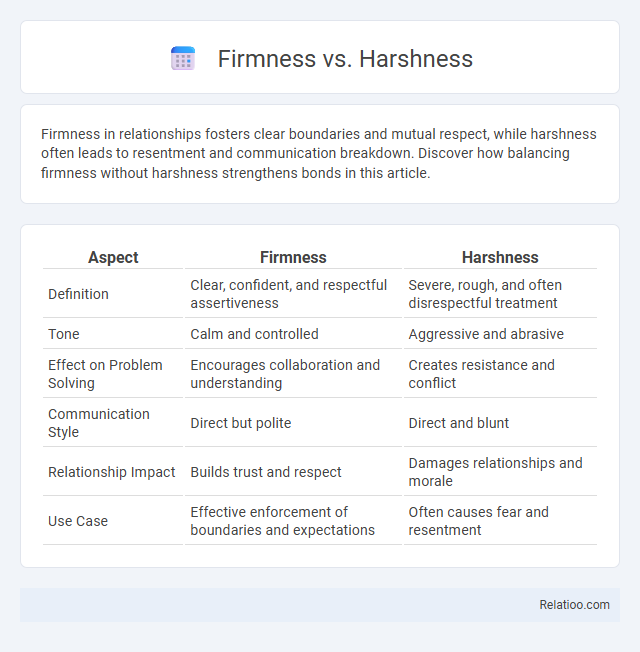Firmness in relationships fosters clear boundaries and mutual respect, while harshness often leads to resentment and communication breakdown. Discover how balancing firmness without harshness strengthens bonds in this article.
Table of Comparison
| Aspect | Firmness | Harshness |
|---|---|---|
| Definition | Clear, confident, and respectful assertiveness | Severe, rough, and often disrespectful treatment |
| Tone | Calm and controlled | Aggressive and abrasive |
| Effect on Problem Solving | Encourages collaboration and understanding | Creates resistance and conflict |
| Communication Style | Direct but polite | Direct and blunt |
| Relationship Impact | Builds trust and respect | Damages relationships and morale |
| Use Case | Effective enforcement of boundaries and expectations | Often causes fear and resentment |
Understanding Firmness vs Harshness: Key Definitions
Firmness refers to a confident and steady approach that conveys authority without aggression, while harshness implies a severe or unkind tone that can alienate others. Understanding the subtle distinctions between firmness and harshness helps you maintain effective communication that is both respectful and assertive, preventing misunderstandings. Key definitions highlight firmness as controlled strength and harshness as excessive rigidity or cruelty in speech or behavior.
Why Distinguishing Firmness from Harshness Matters
Distinguishing firmness from harshness is crucial because firmness conveys confidence and clarity without damage, while harshness often implies cruelty or insensitivity that can strain relationships. Effective communication depends on a firm tone that commands respect and sets boundaries, whereas harshness risks alienating or offending the audience. Understanding this difference enhances leadership, conflict resolution, and interpersonal dynamics by promoting assertiveness without aggression.
Psychological Impacts of Firmness and Harshness
Firmness promotes psychological safety by setting clear boundaries and expectations, fostering respect and trust in relationships. Harshness, characterized by criticism and aggression, often triggers stress responses and diminishes self-esteem, negatively affecting mental health. Your approach to firmness rather than harshness can enhance emotional resilience and encourage positive behavioral changes.
Real-Life Scenarios: Firmness in Action
Firmness in communication manifests as clear, respectful boundaries that foster understanding and cooperation in real-life scenarios such as workplace feedback or parenting. Unlike harshness, which often leads to resentment and conflict, firmness balances assertiveness with empathy, ensuring messages are received without damaging relationships. This approach enhances professional environments by promoting accountability while maintaining positive interactions.
Recognizing Harshness: Signs and Examples
Harshness is characterized by abruptness, severity, or rudeness in tone, often causing discomfort or offense, unlike firmness, which maintains clarity and authority without negativity. Recognizing harshness involves identifying signs such as raised voices, sarcasm, dismissive language, or excessive criticism that undermine constructive communication. Your ability to distinguish harshness from firmness ensures respectful and effective interactions, promoting positive relationships and clear understanding.
Communication Styles: Firm but Not Harsh
Firm communication emphasizes clarity and confidence without crossing into harshness, which often involves a tone perceived as aggressive or critical. Effective communication balances assertiveness with respect, ensuring messages are direct yet considerate to maintain positive relationships. Mastering a firm but not harsh style enhances leadership and conflict resolution by promoting understanding rather than defensiveness.
Firm Leadership vs. Harsh Management
Firm leadership emphasizes clear expectations, consistent feedback, and respect, fostering a motivated and productive work environment. Harsh management relies on intimidation, excessive control, and punitive measures, often leading to employee disengagement and high turnover rates. Cultivating firm leadership enhances team trust and performance, while harsh management undermines morale and organizational stability.
Building Respect Through Firmness, Not Fear
Building respect through firmness requires clear boundaries and consistent communication, which fosters trust and understanding in your relationships. Harshness, on the other hand, often generates fear and resentment, undermining your authority and damaging long-term connections. Your ability to be firm without crossing into harshness creates a respectful environment where influence is earned instead of imposed.
Strategies to Transform Harshness into Firmness
Transforming harshness into firmness involves adopting clear, assertive communication without aggression, emphasizing respect and empathy to maintain authority while fostering positive interactions. Techniques such as active listening, setting consistent boundaries, and using calm, confident language help recalibrate tone and reinforce firm leadership. Implementing these strategies can improve relationships, enhance conflict resolution, and promote a constructive environment in both personal and professional settings.
Choosing Firmness for Positive Influence and Growth
Choosing firmness in communication establishes clear boundaries and promotes respect without creating tension or discomfort typically caused by harshness. Your approach balances assertiveness with empathy, fostering a positive environment that encourages growth and constructive feedback. This firm yet considerate stance enhances collaboration, boosting motivation and long-term success.

Infographic: Firmness vs Harshness
 relatioo.com
relatioo.com